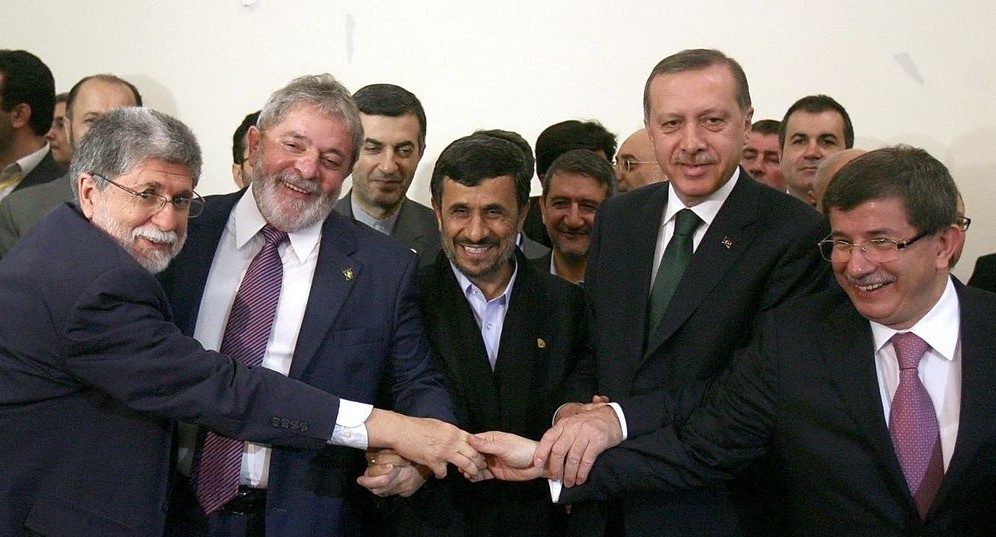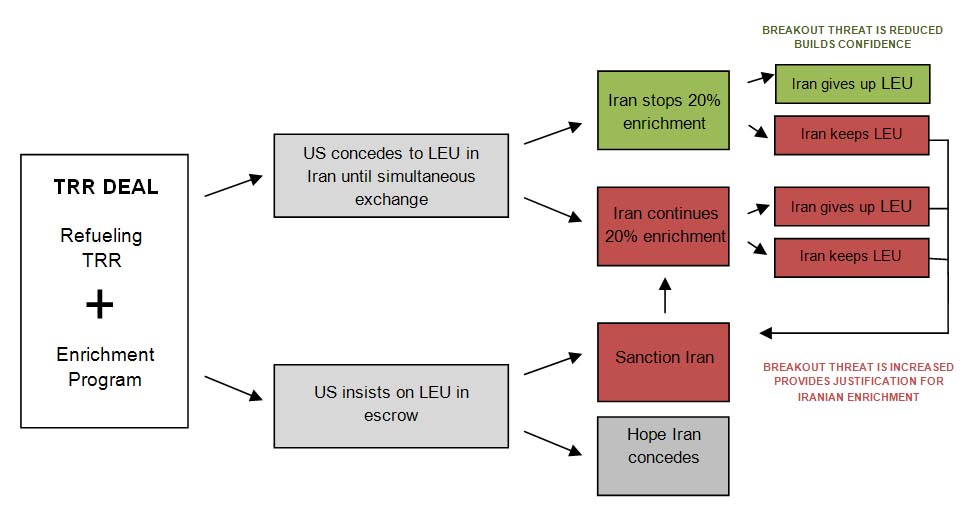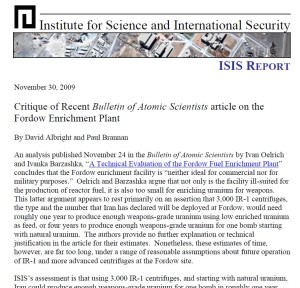Towards Enhanced Safeguards for Iran’s Nuclear Program
Iran’s controversial nuclear program has been front and center on the international stage for more than eight years. Despite negotiations, sanctions, and political tug-of-war, the United States and its allies have yet to tame Iran’s atomic phoenix. At the center of this nuclear standoff is Iran’s controversial uranium enrichment program and efforts to obtain full nuclear fuel-cycle capabilities. To alleviate concerns about the intended nature of these activities, the United Nations Security Council (UNSC) has demanded -through six resolutions – that Iran suspend enrichment activities as well as construction of a heavy-water research reactor. Yet, Iran has opted to pay no heed to these resolutions and despite numerous proposals from different sides, the stalemate persists.
Dr. Charles D. Ferguson and Dr. Ali Vaez, authored a FAS report (PDF) analyzing the outstanding issues regarding Iran’s nuclear program, and provide recommendations to the major stakeholders in this debate including Iran, the United States, Russia and the International Atomic Energy Agency (IAEA).
Additionally, the report proposes a multipronged approach to resolving this deadlock, including enhanced safeguards and positive-sum diplomacy with incentives for Iran and other aspiring nuclear states.
Using Enrichment Capacity to Estimate Iran’s Breakout Potential
While diplomats and officials claim Iran has slowed down its nuclear drive, new analysis shows that Iran’s enrichment capacity grew during 2010 and warns against complacency as five world powers resume talks.
New Fuel Deal with Iran: Getting Back to Basics
by Ivanka Barzashka
After a year-long stalemate, Iran and the P5+1 seem to have agreed on a day for holding political talks – December 2. Iran’s Foreign Ministry spokesman confirmed last week that the meeting “will not include discussions on fuel swap” – the deal with France, Russia and United States, also known as the Vienna Group, to refuel the Tehran Research Reactor (TRR).
In principle, both Washington and Tehran agree that the fuel deal is still on the table, but the Iranians have been critical of the delay in setting a date for talks, which they interpret could be a lack of “willingness to enter peaceful nuclear cooperation.”
A successful fuel deal is a necessary condition for further engagement. However, circumstances have changed since October 2009, when the Vienna Group first made the fuel offer. Now, the State Department maintains that “any engagement [should be] in the context of that changed reality.” (Most of the Vienna Group’s outstanding concerns were listed in a confidential document to the IAEA, published by Reuters on June 9.)
However, the alleged terms of Washington’s new proposal seem to be muddled and will not have the claimed threat-reduction benefits (for a detailed discussion, see this Oct 29 post.) A technically-grounded analysis of what the fuel deal today can, cannot and ought to achieve is available in “New fuel deal with Iran: Debunking common myths,” published on Nov 2 in the Bulletin of the Atomic Scientists. Some highlights of these two assessments are provided below. (more…)
Iran Fuel Negotiations: Moving Muddled Goalposts

by Ivanka Barzashka and Ivan Oelrich
A year ago, France, Russia and the U.S.—called the Vienna Group—proposed a deal in which Iran would ship out some of its worrying low-enriched uranium (LEU) in exchange for fuel for its medical isotope reactor, called the Tehran Research Reactor (TRR). These narrow technical discussions about the TRR were meant to serve as a confidence-building effort. The negotiations fell apart because of differences about timing of the exchange of material, but they may be about to restart. A year later, the facts on the ground have changed. These new circumstances may call for new negotiating terms, but changes have to make some sense. Calculations show that numbers recently floated by the State Department seem ad hoc and arbitrary and will not have the touted threat-reduction benefits.
On October 27, The New York Times reported that a senior U.S. official believed that the Vienna Group were “very close to having an agreement” on how the original fuel swap offer, made in October 2009, should be changed. One of the new terms would be an increase in the amount of LEU provided from 1,200 kg to 2,000 kg. The State Department explained a day later that “the proposal would have to be updated reflecting ongoing enrichment activity by Iran over the ensuing year.” Iran’s larger LEU stockpile changes Washington’s threat-reduction calculus, which ultimately undermines the confidence-building aspect of the deal.
Another new circumstance is Iran’s production of 20 percent enriched uranium, ostensibly to produce TRR fuel domestically. This is a worrying development because, compared to LEU, a stockpile of 20 percent material would cut by half Iran’s time to a bomb.
Iran’s New Dual Track: A Challenge to Negotiations?

by Ivanka Barzashka and Thomas M. Rickers
Coaxed by Turkey and Brazil, Iran seems to be actively pursuing fuel talks. France, Russia and the U.S. (also known as the Vienna Group) claim that they, too, are interested in a deal, even as the U.S. and EU passed their own tougher sanctions against the Islamic Republic as part of a dual-track approach. Now Tehran may even be willing to address what was once the major hindrance to a deal: its 20 percent enrichment. Yesterday, Ali Akbar Salehi, Iran’s atomic energy head, said his country “will not need to enrich to 20 percent if [their] needs are met.” And yet on July 18, the Majlis passed a law requiring the government to continue 20 percent enrichment and manufacture own fuel, which is an apparent contradiction to negotiations for foreign fuel supply. Clearly, Iran is sending mixed messages. But does this mean there is an internal disagreement about nuclear policy? Or is Iran not serious about a fuel deal? (more…)
Will Iran Give Up Twenty Percent Enrichment?
 |
by Ivanka Barzashka
In response to sanctions, Iran’s parliament adopted the Nuclear Achievement Protection Bill on July 18. Among other things, the law requires the government to continue 20 percent enrichment and provide fuel for the Tehran Research Reactor (TRR). Although this aspect of the legislation has largely fallen below the news radar, it raises important questions about the future of nuclear talks, which Iran has postponed until September as “punishment” of the West.
Iran says it is enriching to higher concentrations to manufacture its own fuel for the TRR, but a stockpile of 20 percent enriched uranium will reduce by more than half Iran’s time to a bomb (when compared to its current stockpile of 3.5 percent LEU). Now Iran’s higher-level enrichment may have become the connection between sanctions and a fuel deal that will hinder any engagement options. However, there is still time to explore resolutions to the impasse.
Ivan Oelrich and I have co-authored an FAS issue brief that traces the history of Iranian higher-level enrichment efforts in an effort to understand Tehran’s nuclear intentions. We were driven by the question: Will Iran, at this stage, give up twenty percent enrichment? Three distinct periods were analyzed: (1) from the beginning of 20 percent enrichment to the Tehran Declaration, (2) from the Tehran Declaration to the passing of UN sanctions, and (3) after sanctions. (more…)
Iran Beat Us to It.
Ivan Oelrich and Ivanka Barzashka
Back in October, when Iran put in a request to the IAEA for a new load of fuel for its medical isotope reactor in Tehran, the United States proposed that Iran ship out an equivalent amount of its low enriched uranium (LEU) in exchange. It turns out, purely coincidentally, that the amount of LEU equivalent to about 20-years worth of fuel for the reactor was almost exactly the amount that Iran would need as feedstock to produce a bomb’s worth of material. No one seems to question Iran’s right to purchase fuel, but the purpose of the swap was two-fold: to get the bomb’s worth of LEU out of Iran, which would have left Iran with less than a bomb’s worth of LEU feedstock, and to provide a seed for improved cooperation and trust. (more…)
Twenty Percent Solution: Breaking the Iranian Stalemate
by Ivanka Barzashka and Ivan Oelrich
Iran and the rest of the world are stalemated. Obama’s deadline for Tehran to address concerns about its nuclear program passed at the end of 2009, so the White House is moving to harsher sanctions. But the US is having trouble rallying the needed international support because Iranian intentions remain ambiguous. The deadlock includes negotiations on fueling Iran’s medical isotope reactor. With no progress on that front, Iran has begun its own production of 20-percent uranium for reactor fuel, a worrying development that could put Iran closer to a nuclear weapon. Yet, even while talk of sanctions escalates, Tehran says it is still interested in buying the 20 percent reactor fuel from foreign suppliers.
The Tehran Research Reactor (TRR) deal has backfired. The offer, to trade a large part of Iran’s low enriched uranium (LEU) for finished TRR fuel elements, was meant to abate the potential Iranian nuclear threat by reducing Iran’s stockpile of enriched nuclear material. By artificially coupling two distinct problems, re-fueling the TRR and Iran’s enrichment program, the US, France and Russia have given Tehran a reason, even a humanitarian one, to enrich to higher concentrations. The move to 20 percent enrichment will reduce by more than half the time needed for Iran to get a bomb’s worth of material. (more…)
The Revelation of Fordow+10: What Does It Mean?
According to a recent article by the New York Times, Western intelligence agencies and international inspectors now “suspect that Tehran is preparing to build more [enrichment] sites”. This revelation, according to the newspaper, comes at a “crucial moment in the White House’s attempts to impose tough new sanctions against Iran.”
However, these “suspicions” come months after Iran publicly disclosed such intentions. Tehran declared plans to build 10 additional sites on 29 November 2009, a couple of days after an IAEA Board of Governors resolution called on Tehran to confirm that it had “not taken a decision to construct, or authorize construction of, any other nuclear facility” and suspend enrichment in accordance with UN Security Council resolutions.
At the time, the Iran’s decision to construct more enrichment sites was widely dismissed in the West as an act of defiance and unlikely more than mere bravado. On 30 November 2009 the New York Times wrote that “it [was] doubtful Iran could execute that plan for years, maybe decades”. The same article referred to a high-ranking Institute for Science and International Security (ISIS) official claiming that taking the declaration seriously was “akin to believing in the tooth fairy” and that this effort would likely produce “‘one small plant somewhere that they’re not going to tell us about’ and be military in nature.”
In fact, a week before Iran’s original announcement, Ivan Oelrich and I argued in an article at the Bulletin of the Atomic Scientists that Fordow is likely one of many similar sites. A technical analysis of the facility’s planned capacity showed that, alone, it was not well-suited for either a commercial or a military function. The facility’s low capacity also undermined other strategic roles suggested by official and quasi-official Iranian sources – that Fordow is a contingency plant in case Natanz were attacked or that Fordow was even meant to deter an attack on Natanz. (more…)
Judging the Mood at the IAEA
by Ivanka Barzashka and Ivan Oelrich
The latest IAEA report on Iran has been widely touted as containing new evidence of Iranian weapons work and as a sign of the Agency’s new hard-line attitude toward the Islamic Republic under its new Director General Yukiya Amano. We believe the document has been seriously misrepresented in the media and elsewhere, which could have dangerous consequences. We made this argument in a recent op-ed in the Bulletin of the Atomic Scientists.
We should all bother to do a little reading and get our facts straight. If there was a case for new crippling sanctions or for bombing Iran before, the report adds nothing new. The February report contains no new evidence of Iranian weapons work that was not already in the public domain. There is no independent IAEA assessment that Iran currently has or has ever had a nuclear weapons program. This is also hardly the first time that the Agency has addressed outstanding questions pertaining to the possible military dimension of Iran’s nuclear program and has asked for Iran to respond.
Very limited space in our brief Bulletin op-ed did not allow us to address the issue of Amano’s allegedly new tougher tone. The February document, being Amano’s first, has been subject to an exegesis to discern potential attitudes from the director and has been described by Western media as blunt and even confrontational. Inside Iran, the issue of tone has been viewed by some as a “direct result of a change in leadership, and not the outcome of an unbiased evaluation.” (more…)
Flight Testing a Centrifuge
On 13 January, Ivanka Barzashka and I gave a briefing at the AAAS on our work regarding Iran’s uranium enrichment capacity. Joshua Pollack also gave a briefing, which he has described. Joshua’s analysis is thorough and interesting but I think I would use a different distinction than the “actual” and “nominal” values that he defines.
Pollack shows how the estimates of the capability of Iran’s centrifuge, the IR-1, have declined over time. That is intriguing but I worry that it makes the calculations that Ivanka and I and others have performed using data reported from International Atomic Energy Agency (IAEA) on-site inspections seem like the next step in a series of similar estimates. They are not. There are two very different types of approaches being taken here. Here I present an analogy that I think might make the differences clear. (more…)
Response to Critiques Against Fordow Analysis
by Ivanka Barzashka and Ivan Oelrich
Our article “A Technical Evaluation of the Fordow Fuel Enrichment Plant” published in the Bulletin of the Atomic Scientists on November 23 and its technical appendix, an Issue Brief, “Calculating the Capacity of Fordow”, published on the FAS website, have sparked quite a discussion among the small community that follows the technical details of Iran’s program, most prominently by Joshua Pollack and friends on armscontrolwonk.com (on December 1 and December 6) and by David Albright and Paul Brannan at ISIS, who have dedicated two online reports (from November 30 and December 4) to critiquing our work. (more…)

